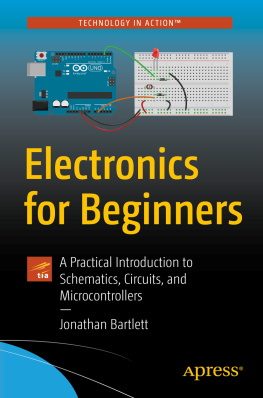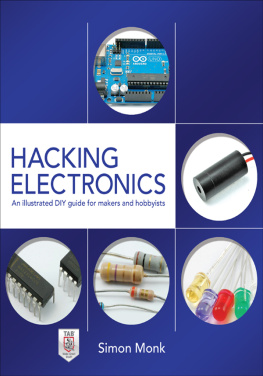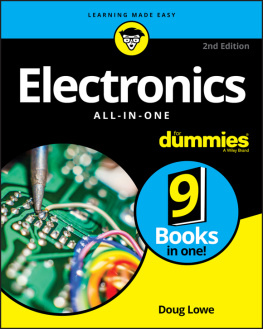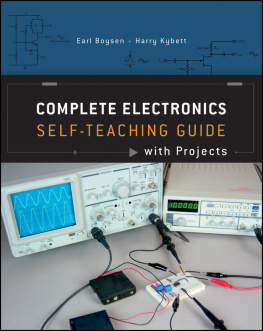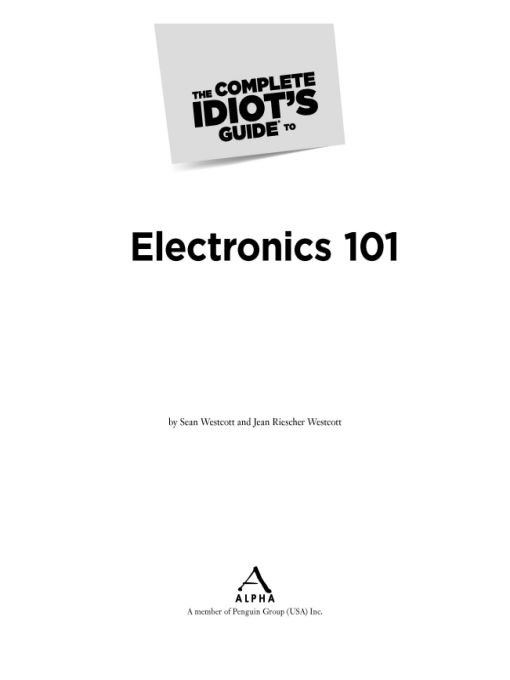Table of Contents
To Ian Wolfgang and Megan Grace, thank you for all you have taught us and for listening when we teach you. Always be true to yourself and nice to the puppies.
Introduction
The study of electronics can be a little overwhelming when you start out. But without assuming that you remember everything from your general science classes, we take you through it all step by step so that you will gain confidence in your understanding of the material. This doesnt mean that we give you a dumbed-down version of electronics, but it does mean that we cover the topics in a more digestible style. We believe that by making the effort to wrap your head around some of the harder topics, you will find it easier to progress into further study of electronic theory or hands-on experimentation.
We believe that a new revolution is under way. Electronics has always had a thriving hobbyist population, especially in the 1960s and the 1970s. There were magazines, corner electronics stores, and clubs where enthusiasts could meet and share their creations. It had its subcultures from amateur radio enthusiasts to model rocket builders. In the 1980s, this culture grew to include people building personal computers before such companies as IBM and Apple began to mass produce them.
The hobbyist field changed as electronics advanced. The increasing sophistication and miniaturization of electronic components and the products built with them made hobbyistbuilt electronics pale in comparison to their flashier, mass-produced competition. But those same advances are now putting the design and production back into the hobbyists hands. Perhaps egged on by battling robots out of university engineering departments, a new generation of electronics buffs is tinkering with technology. With affordable microcontrollers and a wide range of products and information available online, the hobbyist can design and build machines that recharge the ideas of homebrew and do-it-yourself. We can all become makers.
How This Book Is Organized
Part 1, The Fundamentals, covers electronics basics from the atoms up. You learn about currents, AC and DC voltage, and find out how they all work together to power our world.
Part 2, Your Workspace and Tools, introduces the tools of the trade, from the low-tech soldering iron that makes your connections to the high-tech digital multimeter, and offers advice for setting up a shop and working with electricity safely.
Part 3, Electronic Components, gives you the nitty-gritty on circuits, capacitors, diodes, transistors, and power supplies. These components are the workhorses of electronics, keeping things powered, amped up, and running smoothly.
Part 4, Getting to Work, keeps you busy soldering parts together and creating your own power supply. Once you have these skills under your belt, youre ready to start buildingand inventingyour own electronic devices.
Part 5, Going Digital, teaches you to think like a computer. You learn how integrated circuits put digital signals to work and how to use memory to store the instructions that run your gadgets.
Part 6, Constructing a Robot, helps you use everything you learned from the previous parts to create your own robotone that can move on its own, sense its environment, and communicate with your computer. What will you build next?
Extras
Throughout the book, youll find the following sidebars offering additional insights:
DEFINITION
Sometimes it helps to have things stated just a little more directly. In these sidebars, we save you from having to grab a dictionary.
TITANS OF ELECTRONICS
Not just a parade of historical figureshere we invite you to put yourself in their shoes. These sidebars offer a closer look at the folks who looked at things a little differently and changed the world with their ideas.
HIGH VOLTAGE!
When handled safely, electricity can be safe. But the consequences of not respecting its potential for harm are serious. The more you understand how electricity moves, the better you can prepare and work safely with it.
WATTAGE TO THE WISE
Here youll find straightforward advicesometimes practical, sometimes more philosophical.
Acknowledgments
We would like to thank the people who helped us bring this book to publication. First, we would like to thank our agent Bob Diforio for introducing us to our fine and patient editors Mike Sanders and Jennifer Moore. Early enthusiasm and advice from Andr Rebelo and Extech Instruments Corporation, and the use of the Extech EX210 multimeter, were greatly appreciated. We value the advice of our technical editors, Bob Godzwon and John OBrien. We thank the SparkFun team, including AnnDrea Boe, for helping us create supply lists and Secret Labs Chris Walker for being excited about and supportive of our use of their microcontroller platform. Randall Monroe, of XKCD, honored us in allowing our use of his Circuit Diagram comic, we offer our thanks for his generosity. The readers and contributors to Netduinos forums provided advice in the true spirit of free as in beer.
We would also like to thank our colleagues and especially our family for supporting us as we worked through many beautiful weekends.
Special Thanks to the Technical Reviewer
The Complete Idiots Guide to Electronics 101 was reviewed by an expert who double-checked the accuracy of what youll learn here, to help us ensure that this book gives you everything you need to know about electronics. Special thanks are extended to Bob Godzwon.
Trademarks
All terms mentioned in this book that are known to be or are suspected of being trademarks or service marks have been appropriately capitalized. Alpha Books and Penguin Group (USA) Inc. cannot attest to the accuracy of this information. Use of a term in this book should not be regarded as affecting the validity of any trademark or service mark.
Part 1
The Fundamentals
Electronics involves controlling the invisible. Most of the time, you see the effect of electricity but not the actual movement of electric current. This part pulls back the curtain on that hidden world to give you a peek at how electricity works at the atomic level.
It all starts with tiny, charged particles called electrons. Youll learn how and why electrons move in the natural world and how people have harnessed their power using circuits.
No overview of electronic theory would be complete without an explanation of how current (the flow of electrons, also known as electricity), voltage (the push that is caused by the attraction of positive to negative), and resistance (the push back of insulators) work. You will find out what power really means and the ways that all of these forces interact.




